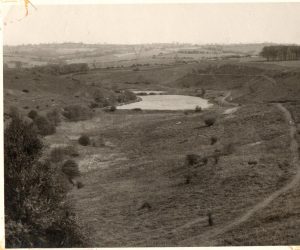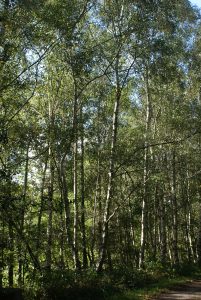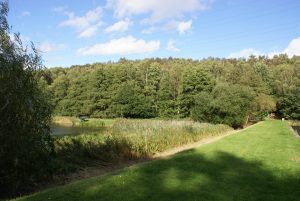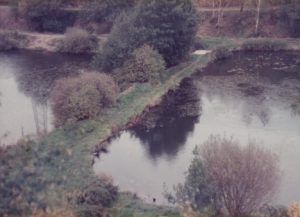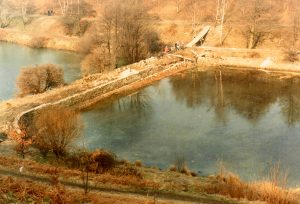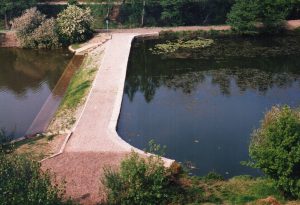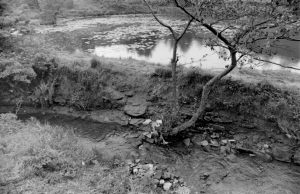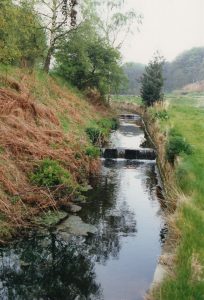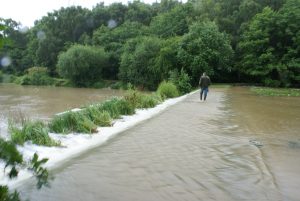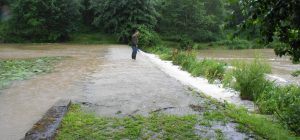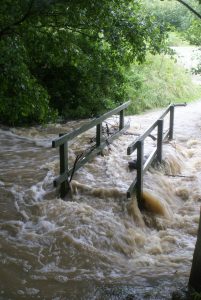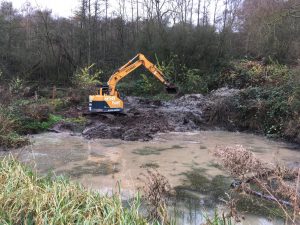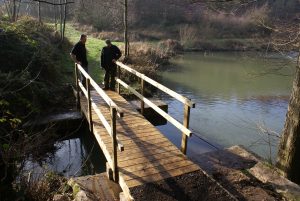Today the words Climate Change are on everyone’s lips. The effects are reportedly being seen across the world and take various forms and affect many thousands of people. As we sit at home watching horrendous stories of huge fires, massive floods, droughts and people being made homeless. it is easy to believe that these are someone else’s problems, that we as individuals will not be affected. But there are numerous problems nearer to home, problems that aren’t seen on TV, or discussed on the radio or in the press, problems that will affect each and every one of us, problems that we all can address to try and reduce the causes and to try to limit their effects. This is the story of how the Angling Club is, and continues to work to limit climate change and its effects both in the Park, on the fishery and beyond.
The history of the Park before Phoenix purchased it in 1972 is broadly detailed in the About Us section of this web site. A detailed history, with pictures, from the 17th century up until modern times can be seen in the book The Story of Ravenfield Ponds (And the anglers that fished there), available from Phoenix Sports and Recreation, price £10.
A number of points are worthy of special note from the time at which the Park was purchased.
– The valley contained three ponds, each in a poor state of repair. Each of the ponds were contained by simple earthen dams and had been so since their conception hundreds of years ago.
– Other ponds which had been in existence had been lost.
– Revetments to the stream which runs beside the ponds were almost defunct.
– The Park was almost devoid of trees.
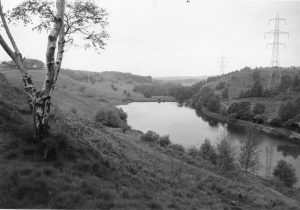
In addition to renovating Park features such as boundary walls, hedge planting, etc, the Club embarked on a serious tree planting exercise the results of which we see in the extensive woodland we see today. But more of that later.
The Club also began reinstating the three obvious ponds and those previously lost as a result of siltation etc. Much of this work was carried out under the guidance of engineers at SYCC. In addition to desilting Burcliff, the New, the Great and latterly the Bridge Pond the Club was advised to improve the longevity of the dam structures by facing the earthen banks with facing stone walls and to cover the top and back of the dams with interlocking proprietary concrete blocks.
The purpose of this expensive and somewhat time-consuming exercise we were told was to protect them against 1 in 1000-year floods. Back then the Club expressed some amazement that structures which had stood for hundreds of years needed such specialist attention. But times change.
At the same time, an exercise of repairing the revetment wall which ran alongside the New, Carp and Great Ponds was begun. Walls which it was suggested had been built when the ponds themselves were constructed with the purpose of diverting the stream, which originally ran in the bottom of the valley, where the ponds now are, away from the ponds to prevent silting. Much of the length of this wall was lost over time with the result that in many places the stream was eroding what effectively were pond banks. Over a period of years, the whole length of the wall was reconstructed preventing further erosion.
Opposing climate change.
Just prior to the Millenium we were opposing climate change without knowing when a plan was proposed to outcrop coal over Conisborough Parks, to the east of Ravenfield. We strongly objected.
Part of the plan was to remove excess/unwanted water via Conisborough/Hooten Brooks and our online ponds down into the Don. The potential for pollution was obvious and uppermost in our minds. Therefore in addition to the work on the original ponds the Club also established a new pond at the point where Conisborough Brook meets Hooten Brook. This was not a restoration but a back up plan to monitor the proposed coal out cropping in Conisborough Parks.
Most of all the restoration works work took place prior to or just after the Millennium and up until it was completed the whole Park had remained essentially as it was built hundreds of years ago. Until then it had withstood all manner of weather and also the ravages of the military training and POWs during and after WW2.
Fast forward then until more recent times.
Debates about global warming and climate change were in their infancy as the new Millennium began but it is clear now that their effects, although we never realised it, were not.
The summer of 2007 was the wettest on record, 414.1mm of rain fell across England and Wales in June and July, more than at anytime since records began in 1766, oddly enough when many of the original works were being carried out in the Park.
Sheffield, Doncaster and latterly parts of the Midlands suffered extensive flooding (At the time climatologists denied that it was as a result of global warming, stating that it was as a result of a freak event. Strangely a second freak event took place less than one month later in the Midlands when the rivers Severn and Thames overflowed their banks causing further extensive flooding.) The Park was no exception and for the first time in living memory each of the ponds over topped its dam. It was a frightening experience and one can only speculate what would have happened if the original earthen structures had been the only protection to dams bursting and potentially Hooten Roberts flooding.
But 2007 wasn’t a one off. December 2015 was, at the time, the wettest month on record and once again flooding and over topping of the ponds occurred. Perhaps the most affected was the relatively new stock pond at the end of Conisborough Brook where because the overflow spillway was unable to take all the extra water it ran over the top of the dam causing extensive damage. Damage which was latterly repaired.
Just five years later in November 2019 the Park suffered a rerun. Once again heavy rain caused extensive flooding in the local area and across the wider region. The effects in the Park mirrored those seen previously, ponds overtopped their dams, further excessive damage was experienced in the new stock pond and the bridge across the stream linking both banks of the Bridge Pond was totally destroyed with pieces being found some quarter of a mile downstream. Furthermore, a small pond, for dogs to use, constructed beside the concessionary path was completely silted up with material from ‘the tip’ as was a large area of the original stock pond below it.
Over the period and particularly since 2019 extensive, expensive, repair works have been carried out, most notable the provision of another spillway on the new stock pond, a new bridge being built to facilitate access on the Bridge Pond, desilting the ‘dog’, old stock, and Bridge Ponds.
So why the problems?
There is little doubt that the underlying cause is climate change. The heavy rainfall that has resulted in the flooding problems has not been seen in the past. Had it been so it is extremely unlikely that the ponds as they were when the Park was purchased in 1972 would have been able to stand the strain. More than likely the dams of the original structures would have failed allowing huge quantities of water to cascade down the valley towards Hooten Roberts.
There are however other contributory factors.
Water entering both Conisborough and Hooten Brooks collects more rapidly if farmers do not adopt sensible farming practices which hold back run off. Such practices are only just being accepted by modern farmers.
In 2012 following previous scares at Ulley Reservoir and no doubt in response to leaks on the reservoir at Firsby, RMBC lowered the level of the spillway on Firsby Reservoir on the advice of engineers. Prior to this, and possibly because the dam itself leaked, the reservoir was rarely more than half full. The result of this being that in times of heavy rainfall the reservoir acted as a sump absorbing much of the rain and run off from adjoinging land and that above, before releasing water downstream to the Park. That situation no longer exists.
Excessive water arising via Firsby Reservoir has been seen to spill over from the stream banks directly into the New Pond in huge quantities. This again has been exacerbated when the road crossing the brook about the Park was washed away with tonnes of material entering the stream and effectively raising the bed and hence the stream’s ability to carry water.
An understanding of these gave rise to quite recent work being carried out above the New Pond where mechanical equipment was brough it to clear the stream bed and build a bund beside the stream and prevent it overflowing and hence overtopping first this pond and then latterly the others downstream.
So there are some of the physical efforts to reduce the effects of climate change, what about the causes?
We have seen how flooding is becoming part of modern life. Much of this can be minimised by holding back rainfall in the areas in which it falls. Many methods have been proposed but perhaps one of the most effective is land management, the use of wooded areas and good ground cover. Since Phoenix have owned the Park extensive planting has been carried out, to such an extent that today some 50 or so acres are woodland or semi-woodland. And this not only helps contain rain falling on the land but also reduces CO2 by photosynthesis, the natural conversion of CO2 to carbon, by plants and trees, and the production of oxygen. Estimates as to the effectiveness of trees vary dependent on the type and age of trees, but it could be that Park is reducing CO2 by 125 tonnes each year.
Studies have also shown that ponds too help reduce CO2 in a similar manner with aquatic plants and algae, and so our approximately 10 acres of water also add to the total.
We’re working hard to improve our environment, to contain/limit the effects of climate change, and protect the Park and the ponds for the benefit of future users.
You can help us by supporting us financially and making a donation.

